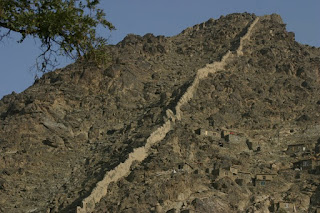What is the name of these fair wondrous plants, now somewhat withered, past the fullness of their blossoming, and appearing as with the colours of clouds near the horizon at the setting of the sun with a faint whisper of pink in their feathery aspect, like plumes of some exotic bird, scattered by the roadside?
These may not be the exact words of my companion, but that's how I remember them, more or less, with perhaps a faint inserted echo of Chaucerian English, which somehow I associate with him, at least in my imagination.
(Answer to his question – rosebay willowherb)
We're driving through hills of an extraordinary colour, part-russet from bracken part purple from heather – all in this low sunlight, a summer day slipped into autumn like a surprise thin packet, tied with a ribbon of many colours, a glitter of silk, a slim wedge of shiny paper, with the resulting startling yellows and deep reds of trees glowing among the shades of green. There's also the statuesque profiles of windfarms and we discuss the possibility of painting them rainbow hues, to shed colour on the hillsides, on grey winter days.
It's open day for artists' studios in and around Dunbar. We first visit Lesleymay Miller's and Judith Rowan's in a basement in Church Street. JR notices things - he points out a lobster creel in the garden which I would have failed to see otherwise. I tend to look into the distance, to horizons. Lobster creels and pink roses.
A band playing traditional jazz music can be heard off the High Street, where we go for coffee to the 1650 café. We decide it is so named because that was the time when coffee houses first made their appearance.
We then drive to Stanton, following a narrow country road through velvety corn coloured fields – the road lined with beech-hedges, pale green and yellow tinted – the low sunlight shines in my eyes and I pull down the sun visor. JR looks at the map. I circle a roundabout a couple of times then find the right road. There is no wind and the sunlight laps over the land, in peaceful unhurried waves.
couple of times then find the right road. There is no wind and the sunlight laps over the land, in peaceful unhurried waves.
Aliki Sapountzi's photographs are of Turkey and Afghanistan. The tomb of Shah Abbas. Stony landscapes. Deep blue skies. It seems to me that if you have travelled in a particular landscape then a part of you belongs to it and it is somehow always inside of you so that you are then part of it, inseparable. Seeing images of these places reminds you of that other part of you that's also you. This is the way I feel connected to the photographs of Afghanistan. It then seems inexplicable  that I should be here, when I feel this connection, shiny as copper, stony and dusty as the tracks and mountains, deep blue as the sky – with this other land. Its minerals I feel, part of my hands and fingernails. Lapis in the veins. Turquoise around the finger joints. Bowl of sky like a loose blue scarf around my neck.
that I should be here, when I feel this connection, shiny as copper, stony and dusty as the tracks and mountains, deep blue as the sky – with this other land. Its minerals I feel, part of my hands and fingernails. Lapis in the veins. Turquoise around the finger joints. Bowl of sky like a loose blue scarf around my neck.
I don't have photographs from that time but I remember the deep silence at night, so many moving points of light, stars in the night sky. It's as if there is another perceptive self, one that doesn't always see the lobster pots, may not register the present details but carries its own memory imprint, that returns in feeling like a soft and subtle cloak and its language is more one of shifting light, colour s, and the slopes, curves and hollows of landscape.
s, and the slopes, curves and hollows of landscape.
Its terrain unfolds, it rolls out like a carpet when I see images of that remembered land. Look! it says – step onto this carpet and walk over the thick wool, feel the worn places and the ridges underneath your feet - and it turns into the vegetation and the dust of this land. As if I'm walking in another being's footsteps – smell the baking bread, in the mountain air...
(Images of Afghanistan courtesy of wikipedia)

Comments
I'm reluctantly getting back to commenting.Interesting post,lovely photo of the doorway.
Rubyxx